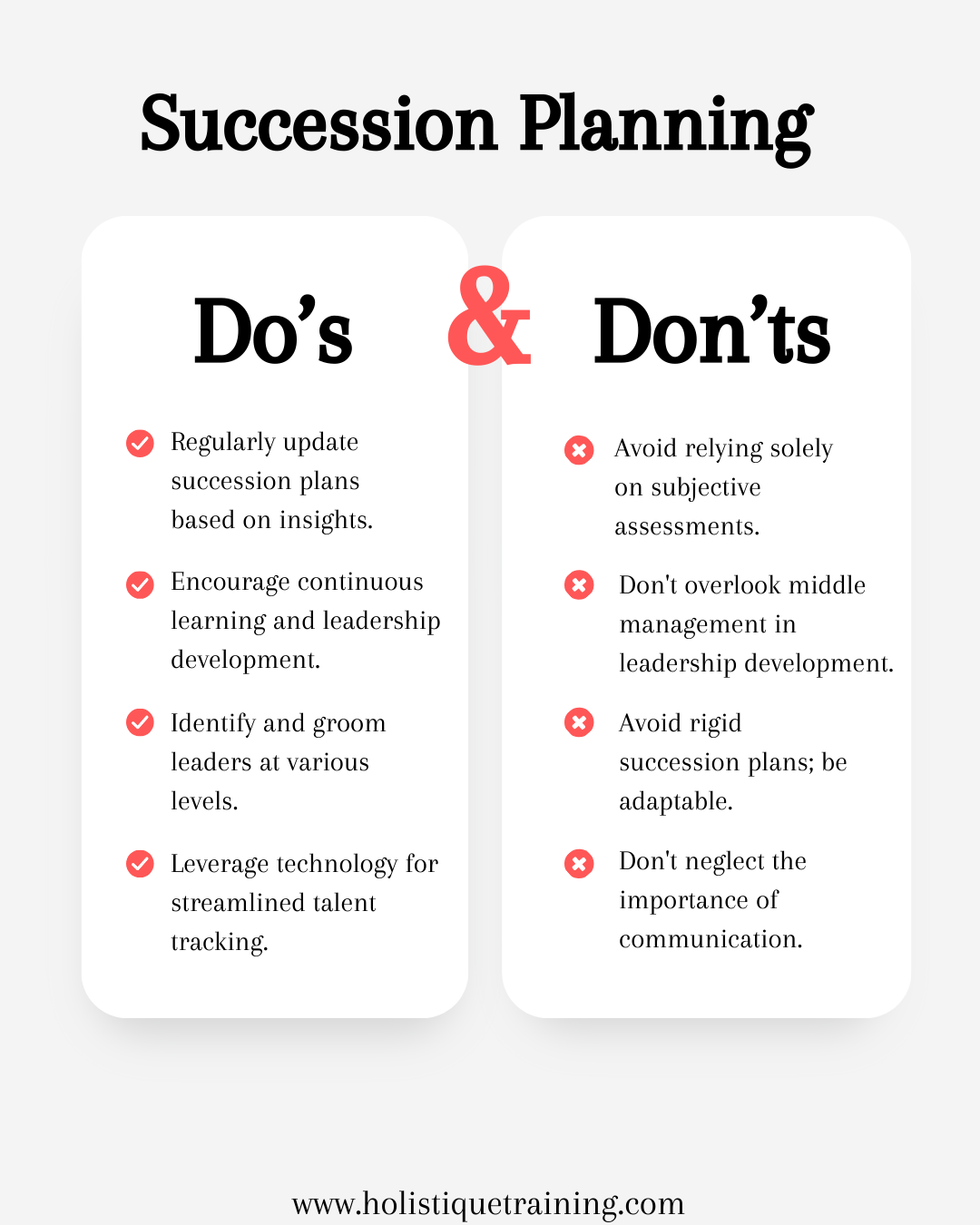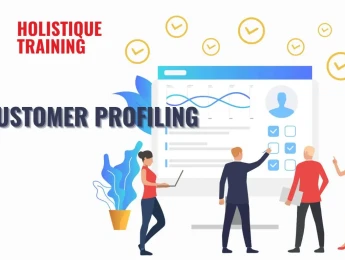- Table of Contents
- Introduction
- What Is Succession Planning in Business?
- Who Is Responsible for Doing Succession Planning?
- 1. Senior Leadership
- 2. Human Resources (HR) Department
- 3. Department Heads and Managers
- 4. Employees at All Levels
- 5. Mentors and Coaches
- 6. Board of Directors
- 7. Cross-functional Teams
- Benefits of Succession Planning
- Continuity of Leadership
- Cultivation of a Leadership Pipeline
- Motivation and Employee Engagement
- Attraction of Top Talent
- Reduction of Recruitment Costs
- Knowledge Retention
- Adaptability to Change
- Enhanced Corporate Reputation
- Risk Mitigation
- Strategic Alignment
- What Is the Process of Succession Planning?
- 1. Identification of Key Roles
- 2. Assessment of Current Talent
- 3. Development Plans
- 4. Ongoing Evaluation
- 5. Successor Readiness
- 6. Transition Planning
- 7. Communication and Transparency
- 8. Integration with Performance Management
- 9. Leadership Training Programmes
- 10. Feedback Loops
- Common Mistakes Companies Do During Succession Planning
- 1. Short-Term Focus
- 2. Neglecting Diversity
- 3. Inadequate Communication
- 4. Overlooking Middle Management
- 5. Ignoring Successor Input
- 6. Rigid Succession Plans
- 7. Failure to Integrate Succession Planning with Business Strategy
- 8. Limited Succession Planning Training
- 9. Overemphasis on Technical Skills
- Tips and Best Practices of Succession Planning
- 1. Start Early
- 2. Embrace Diversity
- 3. Continuous Evaluation
- 4. Involve Key Stakeholders
- 5. Tailor Development Plans
- 6. Communication and Transparency
- 7. Create a Leadership Culture
- 8. Identify High-Potential Individuals
- 9. Successor Readiness Assessments
- 10. Succession Planning Training
- 11. Encourage Leadership Development Programmes
- 12. Plan for Contingencies
- 13. Senior Leadership Involvement
- 14. Utilise Technology
- 15. Celebrate Successes
- Real-world Succession Planning Example
- Succession Planning Software
- Streamlining Talent Tracking
- Data-Driven Decision-Making
- Enhanced Collaboration and Communication
- Accessibility and Flexibility
- Conclusion
Introduction
Succession planning is not merely a corporate buzzword; it is a strategic imperative that determines an organisation's resilience and sustainability in the ever-evolving business landscape. By systematically identifying and developing future leaders, businesses ensure a smooth transition of key roles, mitigating risks associated with leadership vacuums. In this comprehensive exploration, we delve into the intricacies of succession planning, unravelling its significance, processes, and best practices that can elevate a company's long-term success.
What Is Succession Planning in Business?
At its core, succession planning is the deliberate and systematic process of identifying, nurturing, and preparing individuals to fill key leadership roles within an organisation. It goes beyond the immediate replacement of personnel; it's about cultivating a talent pipeline to steer the company towards its strategic goals.
Who Is Responsible for Doing Succession Planning?
Succession planning is a collaborative effort that involves various stakeholders across an organisation. While the human resources department and senior executives play crucial roles, the responsibility for effective succession planning extends beyond these roles. Here are the key players and their roles in this dynamic process:
1. Senior Leadership
At the apex of the organisational hierarchy, senior leaders are the architects of the succession planning strategy. They set the tone for the entire process by emphasising the importance of leadership development and creating a culture that values talent cultivation. Senior executives are responsible for aligning succession planning with the organisation's overall strategic goals, ensuring that it becomes an integral part of the company's DNA.
2. Human Resources (HR) Department
The HR department serves as the backbone of succession planning. HR professionals are instrumental in designing and implementing the formal structure of the succession planning process. This includes identifying key roles, assessing current talent, and developing strategies for talent retention and development. HR also plays a pivotal role in facilitating communication between various departments and ensuring that the succession planning initiatives align with broader HR strategies.
3. Department Heads and Managers
Succession planning is not a one-size-fits-all endeavour; it requires the active participation of department heads and managers who possess firsthand knowledge of their teams. These individuals are responsible for identifying high-potential employees within their respective departments. By having a deep understanding of the skills and competencies required for critical roles, department heads contribute significantly to the accurate assessment and development of potential successors.
4. Employees at All Levels
Empowering employees at all levels to actively engage in their professional development is a cornerstone of effective succession planning. When individuals understand the potential career paths within the organisation, they are more likely to invest in their own growth. This grassroots involvement ensures a diverse pool of talent and encourages a sense of ownership among employees regarding their role in the company's future.
5. Mentors and Coaches
Mentors and coaches are crucial in succession planning as they guide and support high-potential individuals. Through mentorship programmes, experienced leaders can impart valuable insights, share their experiences, and help develop the skills necessary for future leadership roles. This personalised approach accelerates the growth of potential successors and enhances the overall effectiveness of the succession planning process.
6. Board of Directors
The board of directors plays a supervisory role in succession planning for larger organisations. They provide oversight, ensuring that the strategy aligns with the company's long-term vision. The board may also be involved in selecting and evaluating top leadership, especially in the case of CEO succession.
7. Cross-functional Teams
Incorporating cross-functional teams into the succession planning process ensures a well-rounded perspective. These teams can assess the organisation's talent from multiple angles, considering technical skills, leadership potential, adaptability, and cultural fit. Collaboration among different departments fosters a holistic approach to talent identification and development.
In essence, effective succession planning is a team effort that requires collaboration and commitment from leaders at all levels. By distributing responsibility among senior executives, HR professionals, department heads, managers, employees, mentors, and even the board of directors, organisations can create a robust succession planning framework that anticipates and addresses the evolving needs of the business. This inclusive approach strengthens the talent pipeline and fosters a culture of continuous growth and adaptability.
Benefits of Succession Planning
Succession planning is more than just a contingency measure; it's a strategic investment with far-reaching benefits that positively impact the present and future of an organisation. However, in a survey conducted by SHRM, merely 21% of HR professionals reported having a formal succession plan within their organisations, while an additional 24% acknowledged having an informal plan. That being said, let's explore why businesses should focus more on having a well-executed succession planning strategy, and what it brings to the table.
Continuity of Leadership
The seamless leadership transition is the most immediate and obvious benefit of succession planning. By identifying and grooming potential successors, organisations ensure that key roles can be filled promptly and efficiently. This prevents disruptions in critical functions, maintains stability, and instils confidence among employees, clients, and stakeholders.
Cultivation of a Leadership Pipeline
Succession planning goes beyond finding replacements for departing leaders; it involves cultivating a talent pipeline ready to take on leadership roles at various levels. This proactive approach addresses immediate needs and positions the organisation for sustained success by fostering a culture of continuous leadership development.
Motivation and Employee Engagement
When employees see a clear path for their career progression within the organisation, it is a powerful motivator. Succession planning communicates to employees that their growth and development are valued, encouraging them to invest in their roles and contribute to the company's long-term success. This, in turn, enhances overall employee engagement and retention. In fact, statistics show that a staggering 94% of employers affirmed that the presence of a succession plan has a positive impact on their employees' engagement levels.
Attraction of Top Talent
Organisations with robust succession planning strategies are attractive to top-tier talent. The assurance of a structured career path and opportunities for advancement makes the company more appealing to ambitious professionals. This competitive advantage in talent acquisition becomes particularly crucial in industries where skilled and experienced individuals are in high demand.
Reduction of Recruitment Costs
Succession planning minimises the need for external recruitment to fill leadership positions. By identifying and developing internal talent, organisations can reduce the costs associated with external searches, onboarding, and training. This financial prudence contributes to the overall efficiency and sustainability of the business.
Knowledge Retention
As experienced leaders retire or move on, valuable institutional knowledge may leave with them. Succession planning mitigates this risk by ensuring that knowledge transfer is a deliberate part of the transition process. This helps maintain organisational continuity and prevents the loss of critical insights and expertise.
Adaptability to Change
Succession planning is not just about replacing roles; it's about preparing leaders who can navigate the complexities of an ever-evolving business landscape. Leaders developed through succession planning are more likely to be adaptable, innovative, and capable of steering the organisation through periods of change and uncertainty.
Enhanced Corporate Reputation
A commitment to succession planning reflects positively on an organisation's reputation. It sends a message to clients, investors, and partners that the company is forward-thinking, resilient, and invested in long-term success. This enhanced corporate image can contribute to stronger relationships and increased stakeholder trust.
Risk Mitigation
Identifying and developing a pool of potential successors allows organisations to anticipate and mitigate the risks associated with key personnel changes. Whether due to retirements, resignations, or unforeseen circumstances, having a well-prepared succession plan in place ensures that the organisation can navigate such transitions with minimal disruption.
Strategic Alignment
Succession planning aligns leadership development with the organisation's strategic goals. It ensures that potential successors' skills and competencies align with the company's vision and mission. This strategic alignment contributes to leadership's overall effectiveness in driving the organisation towards its objectives.
In essence, succession planning's benefits extend far beyond the immediate need for leadership transitions. It is a forward-looking strategy contributing to organisational resilience, employee satisfaction, and sustained success. By recognising and harnessing the potential within its ranks, an organisation can build a foundation for enduring excellence in a dynamic and competitive business environment.
What Is the Process of Succession Planning?
Succession planning is not a one-size-fits-all endeavour; it's a dynamic and systematic process tailored to each organisation's unique needs and goals. A well-structured succession planning process involves multiple stages, each contributing to the development and readiness of future leaders. Let's delve into the intricacies of this crucial process:
1. Identification of Key Roles
The foundation of succession planning is the identification of key roles within the organisation. These are positions critical to achieving strategic objectives. Whether it's the CEO, department heads, or specialised roles, a comprehensive list of key positions forms the basis for the entire succession planning process.
2. Assessment of Current Talent
Once key roles are identified, the next step is to assess the current talent pool. This involves evaluating the skills, competencies, and potential of individuals within the organisation. Assessments may include performance reviews, skill gap analysis, and 360-degree feedback to understand each employee's strengths and areas for development comprehensively.
3. Development Plans
Based on the assessment, personalised development plans are created for high-potential individuals. These plans outline specific actions, training, mentorship, and experiences needed to prepare potential successors for leadership roles. Development plans are dynamic documents evolving as the individual progresses and organisational needs change.
4. Ongoing Evaluation
Succession planning is not a one-time event; it's an ongoing and iterative process. Regular evaluations are conducted to assess the progress of potential successors. This involves tracking their development against the goals outlined in their plans, adjusting strategies as needed, and identifying emerging leaders who may not have been initially identified.
5. Successor Readiness
As individuals progress through their development plans, they focus on determining their readiness for leadership roles. This assessment considers their technical skills, leadership competencies, emotional intelligence, and cultural fit within the organisation. Successor readiness is a crucial checkpoint before individuals are considered for key positions.
6. Transition Planning
With identified successors ready to step into leadership roles, a detailed transition plan is developed. This plan outlines the steps, timelines, and responsibilities associated with the transition. It includes knowledge transfer strategies, onboarding processes, and ongoing support mechanisms to ensure a smooth handover of responsibilities.
7. Communication and Transparency
Throughout the succession planning process, communication is paramount. Employees must be aware of the organisation's commitment to leadership development, the criteria for identifying high-potential individuals, and the overall succession planning strategy. Transparency fosters trust and buy-in from employees at all levels.
8. Integration with Performance Management
Succession planning should be seamlessly integrated with the organisation's performance management system. The data and insights gathered through performance evaluations contribute to identifying high-potential individuals and formulating their development plans.
9. Leadership Training Programmes
Organisations often invest in leadership training programs to complement on-the-job experiences. These programmes may cover a range of topics, including strategic thinking, decision-making, communication skills, and emotional intelligence. They provide a structured environment for potential successors to enhance their leadership capabilities.
10. Feedback Loops
Establishing feedback loops is essential for continuously improving the succession planning process. Feedback from employees, mentors, and leaders involved in the process helps identify areas of success and areas that may require adjustments. Regular reviews ensure that the succession planning strategy remains agile and responsive to changing organisational dynamics.
In essence, the process of succession planning is a dynamic and holistic journey that involves careful planning, ongoing assessment, and a commitment to the development of a robust leadership pipeline. By systematically identifying, nurturing, and preparing individuals for key roles, organisations position themselves for sustained success in an ever-evolving business landscape. Succession planning is not just about replacing leaders; it's about building a legacy of leadership excellence.
KPI | Description | Measurement Approach |
Talent Development Rate | Rate of growth in high-potential employees | Percentage increase in identified talents |
Time-to-Fill Critical Roles | Speed of filling key leadership positions | Average days taken to fill critical roles |
Leadership Pipeline Depth | Depth of potential leaders across levels | Number of layers in the leadership pipeline |
Successor Readiness Index | Overall readiness of identified successors | Comprehensive assessment score |
Diversity in Succession Pool | Representation of diversity in leadership | Percentage of diverse candidates identified |
Table 1: KPIs for succession planning
Common Mistakes Companies Do During Succession Planning
Despite recognising the importance of succession planning, many companies stumble due to common pitfalls. Some of these include:
1. Short-Term Focus
One of the most common mistakes is a myopic focus on short-term goals over long-term strategies. Succession planning is inherently a forward-looking process, and companies that prioritise immediate needs at the expense of cultivating a sustainable leadership pipeline may find themselves scrambling when unexpected vacancies arise.
2. Neglecting Diversity
Diversity is not only a moral imperative but a strategic advantage. Failing to incorporate diversity into succession planning can limit the range of perspectives and skills within the leadership pipeline. Companies should actively seek diversity in gender, ethnicity, background, and skill sets to ensure a well-rounded pool of potential successors.
3. Inadequate Communication
Succession planning often involves sensitive topics such as leadership transitions and potential replacements. Lack of transparent communication about the purpose and process of succession planning can create an atmosphere of uncertainty and anxiety among employees. Open and honest communication is key to garnering support and buy-in from the workforce.
4. Overlooking Middle Management
While much attention is often given to grooming top executives, companies may neglect the importance of developing leaders at the middle management level. These individuals are the organisation's backbone and are crucial in executing strategies. Neglecting their development can create a leadership vacuum in critical operational areas.
5. Ignoring Successor Input
Succession planning isn't solely a top-down process. Companies may make the mistake of excluding potential successors from the conversation. Involving these individuals in the planning process provides valuable insights and enhances their commitment to the organisation's future.
6. Rigid Succession Plans
While having a structured plan is essential, companies sometimes make the mistake of being too rigid. Circumstances can change, and the best-laid plans may need adjustments. A lack of flexibility can lead to missed opportunities or, conversely, the persistence of a plan that is no longer aligned with organisational needs.
7. Failure to Integrate Succession Planning with Business Strategy
Succession planning should be intricately linked with the overall business strategy. Companies often make the mistake of developing succession plans in isolation from broader organisational goals. Aligning leadership development with strategic objectives ensures that the succession pipeline is attuned to the company's evolving needs.
8. Limited Succession Planning Training
Not everyone in a leadership position is automatically equipped to conduct effective succession planning. Companies may neglect to adequately train HR professionals, managers, and leaders involved in the process. Without proper training, individuals may make suboptimal decisions, undermining the overall effectiveness of succession planning efforts.
9. Overemphasis on Technical Skills
While technical skills are undoubtedly important, effective leadership goes beyond them. Companies may focus too heavily on technical competencies and overlook critical leadership qualities such as emotional intelligence, adaptability, and strategic thinking. A well-rounded leader requires a balance of technical and soft skills.
In short, recognising and addressing these common mistakes is essential for companies committed to building a resilient and sustainable future through succession planning. By learning from these pitfalls, organisations can refine their strategies, cultivate a robust leadership pipeline, and navigate transitions with confidence and foresight. Succession planning is not just about avoiding immediate disruptions; it's about fortifying the organisation for the challenges and opportunities that lie ahead.
Tips and Best Practices of Succession Planning
Implementing effective succession planning requires a thoughtful and proactive approach. Here are key tips and best practices to enhance the success of your succession planning efforts:
1. Start Early
Begin succession planning long before a leadership vacancy occurs. The earlier you identify and nurture potential successors, the more robust and prepared your leadership pipeline will be. Starting early allows for thorough talent development, reducing the risk of rushed decisions during unexpected transitions.
2. Embrace Diversity
Ensure diversity is a cornerstone of your succession planning strategy. A diverse leadership pipeline brings a variety of perspectives, ideas, and skills, fostering innovation and adaptability. Consider diversity not only in terms of gender and ethnicity but also in professional background, experience, and thinking styles.
3. Continuous Evaluation
Regularly assess the effectiveness of your succession plans. The business landscape evolves, and so should your leadership pipeline. Periodic reviews allow you to adjust strategies, update development plans, and identify emerging talent that may not have been apparent initially.
4. Involve Key Stakeholders
Collaboration is key to successful succession planning. Engage HR professionals, senior leadership, department heads, managers, and employees at all levels. Involving key stakeholders ensures a holistic approach that considers various perspectives and insights.
5. Tailor Development Plans
Personalise development plans for potential successors based on their unique strengths, skills, and areas for improvement. A one-size-fits-all approach may not effectively address the diverse needs of individuals within your organisation. Tailored plans enhance the relevance and impact of the development process.

6. Communication and Transparency
Communication is paramount in ensuring the success of succession planning. Clearly communicate the purpose, goals, and succession planning processes to all employees. Transparency builds trust and understanding, fostering a positive organisational culture around leadership development.
7. Create a Leadership Culture
Instil a culture that values leadership development at all levels. Encourage mentorship, coaching, and knowledge-sharing among employees. A pervasive leadership culture fosters continuous learning, allowing potential successors to grow and develop in an environment that supports their aspirations.
8. Identify High-Potential Individuals
Develop a robust system for identifying high-potential individuals. Look beyond current performance and consider qualities like adaptability, emotional intelligence, and strategic thinking. Regularly assess employees for leadership potential, and adjust your succession plans accordingly.
9. Successor Readiness Assessments
Before promoting individuals into key roles, conduct thorough readiness assessments. Evaluate their technical skills, leadership competencies, cultural fit, and alignment with organisational values. Ensure that potential successors are capable and fully prepared for their new roles' responsibilities.
10. Succession Planning Training
Provide training for HR professionals, managers, and leaders involved in the succession planning process. Equip them with the skills and knowledge necessary to effectively identify, develop, and assess potential successors. A well-trained team ensures the success and longevity of your succession planning initiatives.
11. Encourage Leadership Development Programmes
Supplement on-the-job experiences with formal leadership development programmes. These programmes provide structured learning opportunities, enhancing the leadership capabilities of potential successors. Consider workshops, seminars, and executive education programmes tailored to your organisation's needs.
12. Plan for Contingencies
Anticipate unforeseen circumstances by incorporating contingency plans into your succession planning strategy. Identify backup successors for critical roles and have a plan in place for unexpected events. Being prepared for contingencies minimises disruptions and ensures organisational stability.
13. Senior Leadership Involvement
Active participation from senior leadership is crucial for the success of succession planning. Senior leaders set the tone, provide guidance, and demonstrate the organisation's commitment to leadership development. Their involvement fosters a culture where succession planning is considered a strategic priority.
14. Utilise Technology
Take advantage of technology to streamline and enhance the succession planning process. Specialised software can assist in talent tracking, skill assessment, and performance monitoring. Technology not only increases efficiency but also provides valuable data for continuous improvement.
15. Celebrate Successes
Acknowledge and celebrate the successes of your succession planning initiatives. Recognising and rewarding individuals who have successfully transitioned into leadership roles reinforces the importance of the process and motivates others to engage in their professional development actively.
By incorporating these tips and best practices into your succession planning strategy, you can create a dynamic and effective process that addresses immediate leadership needs and builds a resilient and adaptable organisation for the future. Succession planning, when executed thoughtfully, becomes a cornerstone of sustained success and growth.
Real-world Succession Planning Example
Unilever, a global consumer goods powerhouse, stands out as a prime example of effective succession planning. The company's strategy involves meticulously identifying key roles across its diverse business sectors. Unilever employs a holistic talent assessment process, evaluating individuals based on both current performance and potential for growth, adaptability, and alignment with the company's values.
A cornerstone of Unilever's approach is its robust leadership development programmes, providing a mix of on-the-job experiences, mentorship, executive education, and exposure to diverse business functions. This comprehensive strategy nurtures high-potential individuals and fosters a continuous learning culture within the organisation.
Unilever prioritises a global talent pool, recognising the importance of diversity in its leadership pipeline. The company actively promotes mentorship and coaching, fostering a knowledge-sharing culture and ensuring institutional wisdom transfer.
Regular successor readiness assessments go beyond technical skills, encompassing leadership competencies and a commitment to Unilever's sustainability goals. The company maintains agility and flexibility in its succession planning, adapting strategies to changing market dynamics and leadership requirements.
Transparent communication is a key element of Unilever's approach. The company communicates its succession planning strategy openly, building trust and ensuring employees understand the organisation's commitment to professional growth.
Unilever celebrates the success stories arising from its succession planning efforts. Recognising individuals who transition into key leadership roles motivates them and reinforces Unilever's dedication to cultivating a talent-driven and sustainable future.
In essence, Unilever's holistic and adaptive approach to succession planning is a benchmark for organisations seeking to build resilient and forward-thinking leadership pipelines aligned with their core values and business objectives.
Succession Planning Software
In the digital transformation era, organisations increasingly turn to succession planning software to optimise their talent management strategies. This technology not only streamlines traditional processes but also adds a layer of precision and efficiency to succession planning. Here are the advantages of incorporating succession planning software into your organisational framework:
Streamlining Talent Tracking
Succession planning software centralises information on employees' skills, performance, and potential, providing a comprehensive view for HR professionals and decision-makers. This streamlined approach ensures that high-potential individuals are identified based on accurate and up-to-date information.
Data-Driven Decision-Making
By leveraging software, organisations gain access to data-driven insights crucial for identifying, developing, and retaining future leaders. The analytics provided by these tools enhance the precision and efficiency of decision-making throughout the succession planning process.
Enhanced Collaboration and Communication
Succession planning software fosters collaboration among various stakeholders, allowing HR professionals, department heads, and senior leaders to access and share information seamlessly. This improved communication ensures everyone involved is aligned with the organisation's succession planning goals and strategies.
Accessibility and Flexibility
Cloud-based succession planning software enhances accessibility and flexibility. Stakeholders can access the platform from anywhere, facilitating remote collaboration and accommodating the needs of a geographically dispersed workforce. This accessibility ensures that succession planning remains dynamic and responsive to the organisation's evolving needs.
Embracing succession planning software modernises the process and adds agility to an organisation's talent management strategies. From talent tracking to analytics-driven decision-making, these tools empower organisations to build a robust leadership pipeline, ensuring a seamless transition into the future.
Conclusion
Succession planning is a proactive strategy that transcends the immediate concerns of workforce management. By investing in developing future leaders and creating a robust talent pipeline, organisations ensure their resilience and adaptability in an ever-changing business landscape. From identifying critical roles to embracing diversity and leveraging technology, a holistic approach to succession planning is key to fostering an organisation's thriving and sustainable future.
Finally, succession planning is a dynamic journey, and mastering the art of it is essential for organisational longevity. Elevate your understanding and implementation of succession planning with our course, ‘Succession Management - A Business Necessity.’ Unlock the strategies that empower organisations to thrive amid change and secure a prosperous future. Enrol now and transform succession planning from a necessity into a strategic advantage.























